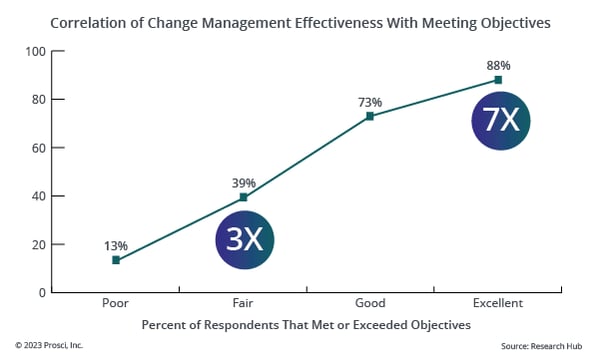5 Tenets of Change Management

4 Mins
Updated: December 20, 2023
Published: March 2, 2021

Results and outcomes from workplace changes are inextricably tied to individual employees doing their jobs differently. When you apply change management to projects and initiatives, you enable employees to adopt changes more effectively, which helps you realize the business objectives you set out to achieve. Change management is about helping the people at the heart of those changes, bridging the gaps between project solutions and results through our collective efforts as change leaders.
The What, Why and How
What does it mean to “manage the people side of change”? Why do we practice change management? How does change management lead to successful change? The answers to these and other common questions about change are found in five foundational tenets of change management, each of which builds upon the others. Together they form the context you need to clarify misconceptions and justify the importance of change management within your organization.
The five tenets of change management are:
- We change for a reason
- Organizational change requires individual change
- Organizational outcomes are the collective result of individual change
- Change management is an enabling framework for managing the people side of change
- We apply change management to realize the benefits and desired outcomes of change
Get Prosci Certified
Learn to manage change on a real organizational project when you attend the Prosci Change Management Certification Program.
Prosci's 5 Tenets of Change Management

As an anchor point for starting a discussion, we must agree that we change for a reason. As simple as this sounds, a key principle for managing change is that a different future state can be envisioned, and we are changing to that future state to achieve a specific and desired outcome. When we say we change for a reason, that does not mean the reason for every change is the same, only that there is a specific reason or objective for a given change. The reasons for change can vary greatly, such as revenue growth, improved customer satisfaction, reduced costs, better product or service quality, reduced risk exposure, improved quality of life, etc.
We do not undertake projects and initiatives because they are fun and exciting—we do so because there is an opportunity to seize, a problem to solve, or most importantly, a chance to improve performance in a meaningful way. A fundamental assumption about change is that something different is possible.

Change only occurs when individuals in the organization begin working in new ways: displaying new behaviors, using new tools, adhering to new processes, and adopting new values. Individual shifts in behavior are the cornerstone of such change. Taken together as a whole, numerous individual shifts like these enable the organization to achieve its desired future state. Organizational change results from people adopting new skills and demonstrating new capabilities. While this seems like common sense, we often wrongly assume that change at an individual level will just happen on its own.
The realization of any change, even large-scale organizational projects and initiatives, is an individual phenomenon at its core. In other words, the degree to which an organizational change produces results correlates directly with the degree of individual change that occurs.

Bringing a change to fruition and achieving specific outcomes is tied to people adopting new behaviors. Once you understand this, you can ask the right questions:
- How many total employees will engage in the change versus how many will opt out or find workarounds (i.e., ultimate utilization)?
- How quickly will employees get on board with the change (i.e., speed of adoption)?
- How effectively will the change be implemented at an individual level (i.e., proficiency)?
Because change is an individual phenomenon, these individual factors can drive or constrain the value a change creates.
Project managers and business leaders sometimes assume that ultimate utilization, speed of adoption, and proficiency—the human factors of change—will automatically reach 100% after being introduced. They fall into the common trap of believing that designing and implementing a business solution is enough to achieve intended results. But without engagement from each employee who must do their job differently, we will not achieve tangible benefits from change.

It is a mistake to view change management as simply a mechanism to reduce employee resistance or mitigate the risk of negative consequences to the organization during change. Change management is much more—it is a robust organizational framework that enables individuals to adopt new values, skills and behaviors, so we achieve business results from change.
As a practical matter, change management leverages the normal mechanisms within an organization to influence and develop employees. We accomplish this through activities such as communications, training and visible sponsorship. At the same time, change management facilitates action at the individual-employee level through coaching and resistance management.
Similarly, “change managers” are not just project team members or change management practitioners. Change managers include leaders, executives, managers, front-line supervisors and employees who equip and enable individuals in an organization to transition from their current state to a new future state.
All of these change management activities and roles comprise a discipline and field of study that fuel individual and organizational transitions.

This final tenet is an essential and distinguishing characteristic of change management. Unlike project management, which focuses on developing and implementing the technical solution, change management focuses on achieving desired outcomes from the technical change by managing people through their individual transitions. And Prosci’s Best Practices in Change Management benchmarking studies consistently show that projects applying effective change management are seven times more likely to meet the project’s objectives.

Although training, communications, sponsorship, resistance management and employee coaching are critical elements of change management, they do not define it. We do not apply change management to enhance communications and training, or to implement employee recognition programs. Nor do we apply change management only to reduce risks to the organization during change, such as lower employee morale, productivity loss, undesired turnover, or negative impacts on customers. You can make a strong case for change management based on mitigating risks. But risk mitigation alone is not the primary objective. Change management’s most important objective is to increase the probability of realizing the desired future state and achieving the associated results from change.
The Case for Change Management
Achieving results from projects and initiatives takes more than communications and training. When you help employees make their individual transitions, you realize more effective outcomes and do so more quickly. Higher adoption and usage, more satisfied employees, greater project ROI, and enhanced organizational agility can be yours. And it starts with understanding the five basic tenets of change management.


